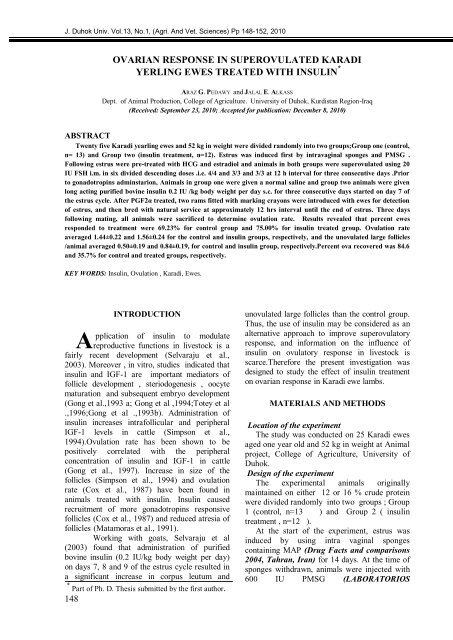The Influence Of Priming Two Cucumber Cultivar Seeds
The Influence Of Priming Two Cucumber Cultivar Seeds
The Influence Of Priming Two Cucumber Cultivar Seeds
Create successful ePaper yourself
Turn your PDF publications into a flip-book with our unique Google optimized e-Paper software.
J. Duhok Univ. Vol.13, No.1, (Agri. And Vet. Sciences) Pp 148-152, 2010<br />
841<br />
OVARIAN RESPONSE IN SUPEROVULATED KARADI<br />
YERLING EWES TREATED WITH INSULIN *<br />
ARAZ G. PEDAWY and JALAL E. ALKASS<br />
Dept. of Animal Production, College of Agriculture. University of Duhok, Kurdistan Region-Iraq<br />
(Received: September 23, 2010; Accepted for publication: December 8, 2010)<br />
ABSTRACT<br />
Twenty five Karadi yearling ewes and 52 kg in weight were divided randomly into two groups;Group one (control,<br />
n= 13) and Group two (insulin treatment, n=12). Estrus was induced first by intravaginal sponges and PMSG .<br />
Following estrus were pre-treated with HCG and estradiol and animals in both groups were superovulated using 20<br />
IU FSH i.m. in six divided descending doses .i.e. 4/4 and 3/3 and 3/3 at 12 h interval for three consecutive days .Prior<br />
to gonadotropins adminstarion, Animals in group one were given a normal saline and group two animals were given<br />
long acting purified bovine insulin 0.2 IU /kg body weight per day s.c. for three consecutive days started on day 7 of<br />
the estrus cycle. After PGF2α treated, two rams fitted with marking crayons were introduced with ewes for detection<br />
of estrus, and then bred with natural service at approximately 12 hrs interval until the end of estrus. Three days<br />
following mating, all animals were sacrificed to determine ovulation rate. Results revealed that percent ewes<br />
responded to treatment were 69.23% for control group and 75.00% for insulin treated group. Ovulation rate<br />
averaged 1.44±0.22 and 1.56±0.24 for the control and insulin groups, respectively, and the unovulated large follicles<br />
/animal averaged 0.50±0.19 and 0.84±0.19, for control and insulin group, respectively.Percent ova recovered was 84.6<br />
and 35.7% for control and treated groups, respectively.<br />
KEY WORDS: Insulin, Ovulation , Karadi, Ewes.<br />
A<br />
INTRODUCTION<br />
pplication of insulin to modulate<br />
reproductive functions in livestock is a<br />
fairly recent development (Selvaraju et al.,<br />
2003). Moreover , in vitro, studies indicated that<br />
insulin and IGF-1 are important mediators of<br />
follicle development , steriodogenesis , oocyte<br />
maturation and subsequent embryo development<br />
(Gong et al.,1993 a; Gong et al ,1994;Totey et al<br />
.,1996;Gong et al .,1993b). Administration of<br />
insulin increases intrafollicular and peripheral<br />
IGF-1 levels in cattle (Simpson et al.,<br />
1994).Ovulation rate has been shown to be<br />
positively correlated with the peripheral<br />
concentration of insulin and IGF-1 in cattle<br />
(Gong et al., 1997). Increase in size of the<br />
follicles (Simpson et al., 1994) and ovulation<br />
rate (Cox et al., 1987) have been found in<br />
animals treated with insulin. Insulin caused<br />
recruitment of more gonadotropins responsive<br />
follicles (Cox et al., 1987) and reduced atresia of<br />
follicles (Matamoras et al., 1991).<br />
Working with goats, Selvaraju et al<br />
(2003) found that administration of purified<br />
bovine insulin (0.2 IU/kg body weight per day)<br />
on days 7, 8 and 9 of the estrus cycle resulted in<br />
a significant increase in corpus leutum and<br />
*<br />
Part of Ph. D. <strong>The</strong>sis submitted by the first author.<br />
unovulated large follicles than the control group.<br />
Thus, the use of insulin may be considered as an<br />
alternative approach to improve superovulatory<br />
response, and information on the influence of<br />
insulin on ovulatory response in livestock is<br />
scarce.<strong>The</strong>refore the present investigation was<br />
designed to study the effect of insulin treatment<br />
on ovarian response in Karadi ewe lambs.<br />
MATERIALS AND METHODS<br />
Location of the experiment<br />
<strong>The</strong> study was conducted on 25 Karadi ewes<br />
aged one year old and 52 kg in weight at Animal<br />
project, College of Agriculture, University of<br />
Duhok.<br />
Design of the experiment<br />
<strong>The</strong> experimental animals originally<br />
maintained on either 12 or 16 % crude protein<br />
were divided randomly into two groups ; Group<br />
1 (control, n=13 ) and Group 2 ( insulin<br />
treatment , n=12 ).<br />
At the start of the experiment, estrus was<br />
induced by using intra vaginal sponges<br />
containing MAP (Drug Facts and comparisons<br />
2004, Tahran, Iran) for 14 days. At the time of<br />
sponges withdrawn, animals were injected with<br />
600 IU PMSG (LABORATORIOS



